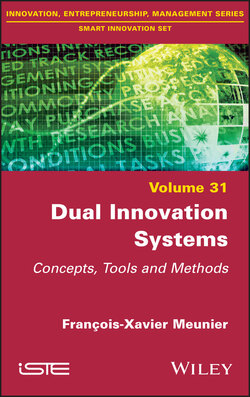Dual Innovation Systems

Реклама. ООО «ЛитРес», ИНН: 7719571260.
Оглавление
Francois-Xavier Meunier. Dual Innovation Systems
Table of Contents
List of Illustrations
List of Tables
Guide
Pages
Dual Innovation Systems. Concepts, Tools and Methods
Introduction
Introduction to Part 1
1. Definitions of Technological Duality. 1.1. Introduction
1.2. Duality. 1.2.1. From spin-offs to duality
1.2.2. Technological duality
1.3. Actors and objectives of duality
1.3.1. Dual strategies of companies
1.3.2. Dual policies of innovation
1.4. Conclusion
2. The Knowledge System as Unit of Analysis. 2.1. Introduction
2.2. Technological knowledge systems and knowledge dissemination. 2.2.1. Unit of analysis
2.2.2. Knowledge dissemination
2.3. Knowledge dissemination and duality. 2.3.1. Dual knowledge
2.3.2. Dual process of knowledge dissemination
2.4. Conclusion
3. Definition and Operation of Dual Innovation System. 3.1. Introduction
3.2. Dual innovation system. 3.2.1. Approach in terms of IS
3.2.2. Definition of a DIS
3.3. Objectives and functions of a DIS. 3.3.1. In economic and technological terms
3.3.1.1. Function 1: identify the actors
3.3.1.2. Function 2: organize dual cooperation
3.3.1.3. Function 3: create synergies
3.3.2. Duality measure within a DIS
3.3.3. DIS for the autonomous vehicle
3.4. Conclusion
Conclusion to Part 1
Introduction to Part 2
Preliminary data presentation
Company database
Patent data
Data extraction procedure
Citation data scope
4. Identification of Technological Knowledge Systems in Defense. 4.1. Introduction
4.2. EDT and analysis of knowledge flows. 4.2.1. Economic dominance theory
4.2.1.1. Minimal and maximal values of the determinant
4.2.1.2. Absolute bounds of the determinant
4.2.1.3. The upper bound of the determinant in case of autarky
4.2.2. Application to knowledge analysis through patents
4.3. Graph theory applied to technological knowledge systems
4.3.1. TKS identification method
4.3.2. Application to knowledge flows
4.4. Conclusion
5. Evaluation of the Dual Potential of Technological Knowledge Systems: Analysis in Terms of Coherence. 5.1. Introduction
5.2. Technological coherence. 5.2.1. Theory of relatedness and coherence
5.2.2. Duality scale in relation to TKS internal structure
5.3. Analysis of the duality of technological knowledge systems
5.4. Conclusion
6. Analysis of the Dual Influence of Technological Knowledge Systems. 6.1. Introduction
6.2. Influence and duality
6.2.1. Internal influence and external influence
6.2.2. Measures of influence
6.3. Dual analysis of influence. 6.3.1. The indicators
6.3.2. Analysis of the duality of a TKS
6.4. Conclusion
Conclusion to Part 2
General Conclusion
References
Index. A, C, D
E, F, G
I, K, L
M, N, P
R, S, T
WILEY END USER LICENSE AGREEMENT
Отрывок из книги
Smart Innovation Set
.....
Figure 1.1. Technology cycle and dual potential. (a) Product-oriented; (b) process-oriented (source: Cowan and Foray 1995, p. 858)
Given these considerations on the temporal dimension, a priori knowledge on the applications of a technology in the future seems unlikely, as the majority of them have multiple uses (Sachwald 1999). In addition to temporality, some consider that future applications of a technology depend in particular on the social network in which it is developed or used (Cowan and Foray 1995; Kulve and Smit 2003). In innovation sociology, the notion of collaboration between network actors is essential for the economic dynamics. The concepts of techno-economic networks (Callon 1991) or sociotechnical networks (STN) (Elzen et al. 1996) point out this aspect; they are also the source of inspiration for the approaches of duality that place the collaborations between actors at the core of the analysis (Kulve and Smit 2003). Their main contribution is that the study of duality is no longer focused on technologies, but on the networks in which they emerge. The characteristics of these networks are susceptible to facilitating dual development. The idea of a temporality in the dual potential, as advanced by Cowan and Foray, is preserved, together with the idea of transfer mechanisms specific to each situation.
.....